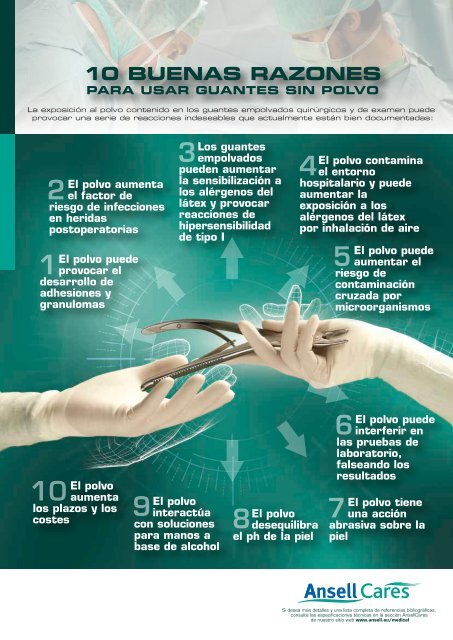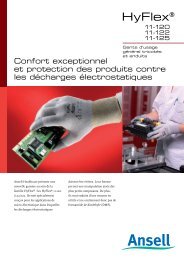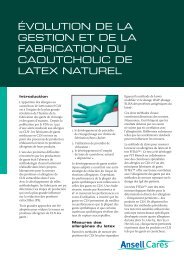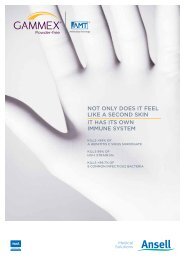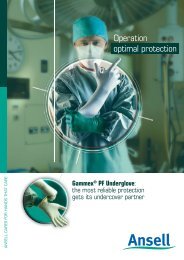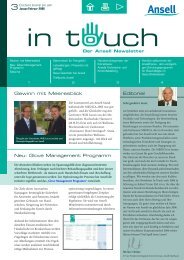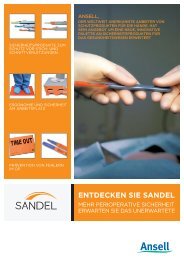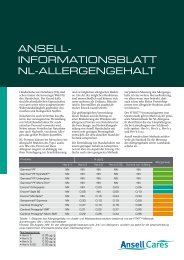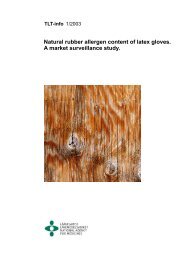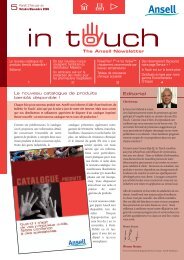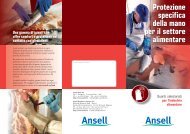10 BUENAS RAZONES PARA USAR GUANTES SIN POLVO
10 BUENAS RAZONES PARA USAR GUANTES SIN POLVO
10 BUENAS RAZONES PARA USAR GUANTES SIN POLVO
Create successful ePaper yourself
Turn your PDF publications into a flip-book with our unique Google optimized e-Paper software.
<strong>10</strong> <strong>BUENAS</strong> <strong>RAZONES</strong><br />
<strong>PARA</strong> <strong>USAR</strong> <strong>GUANTES</strong> <strong>SIN</strong> <strong>POLVO</strong><br />
La exposición al polvo contenido en los guantes empolvados quirúrgicos y de examen puede<br />
provocar una serie de reacciones indeseables que actualmente están bien documentadas:<br />
2<br />
El polvo aumenta<br />
el factor de<br />
riesgo de infecciones<br />
en heridas<br />
postoperatorias<br />
1<br />
El polvo puede<br />
provocar el<br />
desarrollo de<br />
adhesiones y<br />
granulomas<br />
<strong>10</strong><br />
3<br />
Los guantes<br />
empolvados<br />
pueden aumentar<br />
la sensibilización a<br />
los alérgenos del<br />
látex y provocar<br />
reacciones de<br />
hipersensibilidad<br />
de tipo I<br />
4<br />
El polvo<br />
aumenta El polvo<br />
los plazos y los 9 interactúa El polvo<br />
costes con soluciones 8desequilibra<br />
para manos a el ph de la piel<br />
base de alcohol<br />
El polvo contamina<br />
el entorno<br />
hospitalario y puede<br />
aumentar la<br />
exposición a los<br />
alérgenos del látex<br />
por inhalación de aire<br />
5<br />
El polvo puede<br />
aumentar el<br />
riesgo de<br />
contaminación<br />
cruzada por<br />
microorganismos<br />
6<br />
El polvo puede<br />
interferir en<br />
las pruebas de<br />
laboratorio,<br />
falseando los<br />
resultados<br />
7<br />
El polvo tiene<br />
una acción<br />
abrasiva sobre la<br />
piel<br />
Si desea más detalles y una lista completa de referencias bibliográficas,<br />
consulte las especificaciones técnicas en la sección AnsellCares<br />
de nuestro sitio web www.ansell.eu/medical
<strong>10</strong> <strong>BUENAS</strong> <strong>RAZONES</strong> <strong>PARA</strong> <strong>USAR</strong><br />
<strong>GUANTES</strong> <strong>SIN</strong> <strong>POLVO</strong><br />
La exposición al polvo contenido en los guantes empolvados quirúrgicos y de examen<br />
puede provocar una serie de reacciones indeseables que actualmente están bien<br />
documentadas:<br />
1. EL <strong>POLVO</strong> PUEDE PROVOCAR EL DESARROLLO DE ADHESIONES Y GRANULOMAS.<br />
Situación bien documentada en la cavidad peritoneal, pero también se han dado casos en prácticamente cualquier otra<br />
ubicación anatómica, como los ojos, la región oral, la cavidad craneal, el oído medio, el tórax, la vejiga.<br />
1,2,3,4,5,6,7,8,9,<strong>10</strong>,11,12,13,14,15,16<br />
2. EL <strong>POLVO</strong> AUMENTA EL FACTOR DE RIESGO DE INFECCIONES EN HERIDAS POSTOPERATORIAS.<br />
Como la mayoría de los cuerpos extraños, el polvo para guantes disminuye el inóculo bacteriano necesario para producir<br />
abscesos (en este caso el factor de reducción es de al menos <strong>10</strong> veces).15 Además, el polvo retrasa la cicatrización de<br />
las heridas y modifica el proceso normal de reparación, aumentando al mismo tiempo la respuesta inflamatoria de las<br />
heridas. 16,17,8<br />
3. LOS <strong>GUANTES</strong> EMPOLVADOS PUEDEN AUMENTAR LA SENSIBILIZACIÓN A LOS ALÉRGENOS<br />
DEL LÁTEX Y PROVOCAR REACCIONES DE HIPERSENSIBILIDAD DE TIPO I.<br />
Los guantes empolvados pueden presentar niveles muy superiores de alérgenos del látex natural que los guantes sin<br />
polvo, por lo que pueden aumentar la sensibilización al látex o provocar una reacción inmediata de hipersensibilidad de<br />
tipo I por contacto directo. 18,19,20,21,22,23,24,25,26,27,28,29,30<br />
4. EL <strong>POLVO</strong> CONTAMINA EL ENTORNO HOSPITALARIO Y PUEDE AUMENTAR LA EXPOSICIÓN A<br />
LOS ALÉRGENOS DEL LÁTEX POR INHALACIÓN DE AIRE.<br />
El polvo puede unirse a los antígenos proteicos del látex natural (NRL). Estas partículas de polvo recubiertas de<br />
alérgenos / proteínas pueden liberarse en el aire cuando al ponerse o quitarse los guantes. La inhalación o la ingestión<br />
de estas partículas puede provocar sensibilización y diversas reacciones alérgicas al NRL (es decir, síntomas en el tracto<br />
respiratorio superior o irritación ocular). 31,32,33,34,35,36<br />
5. EL <strong>POLVO</strong> PUEDE AUMENTAR EL RIESGO DE CONTAMINACIÓN CRUZADA POR<br />
MICROORGANISMOS.<br />
El polvo de los guantes también puede actuar como vehículo para microorganismos patógenos y oportunistas, lo cual<br />
incrementa los riesgos profesionales tanto de los pacientes como de los profesionales sanitarios. La contaminación por<br />
partículas de polvo de catéteres, riñones perfundidos procedentes de donantes y materiales de odontología cosmética<br />
(coronas, prótesis), entre otras, ha sido ampliamente documentada. 37,38<br />
6. EL <strong>POLVO</strong> PUEDE INTERFERIR EN LAS PRUEBAS DE LABORATORIO, FALSEANDO LOS<br />
RESULTADOS.<br />
El polvo puede causar falsos resultados en algunas pruebas, por ejemplo, PCR o reacción en cadena de la polimerasa,<br />
inmunoensayos enzimáticos o determinadas pruebas del VIH, y el granuloma producido por el polvo puede diagnosticarse<br />
erróneamente como un carcinoma metastásico. 39,40,41<br />
7. EL <strong>POLVO</strong> TIENE UNA ACCIÓN ABRASIVA SOBRE LA PIEL.<br />
El polvo tiene un efecto mecánico sobre la piel de las manos, aumentando su rugosidad tal y como muestran los análisis<br />
con perfilómetro láser de imágenes de la piel de las manos. 42<br />
8. EL <strong>POLVO</strong> DESEQUILIBRA EL PH DE LA PIEL.<br />
El pH de la piel, fundamental para la protección contra microorganismos (bacterias, hongos) suele ser de 5,5. El pH de<br />
la piel permanece alcalino durante horas después de haber utilizado guantes empolvados, por causa de la alcalinidad del<br />
polvo. 42,43,44<br />
9. EL <strong>POLVO</strong> INTERACTÚA CON SOLUCIONES <strong>PARA</strong> MANOS A BASE DE ALCOHOL.<br />
Una vez quitados los guantes, los productos de limpieza para manos a base de alcohol pueden interactuar con el polvo<br />
residual que queda en las manos del personal, produciendo una sensación arenosa en las manos. El polvo tiende<br />
asimismo a manchar las manos con material orgánico que precisa ser eliminado con agua y jabón neutro antes de poder<br />
volver a utilizar los productos a base de alcohol. 45,46<br />
<strong>10</strong>. EL <strong>POLVO</strong> AUMENTA LOS PLAZOS Y LOS COSTES .<br />
En cualquier caso, es necesario eliminar el polvo de guantes tras ponerse unos guantes quirúrgicos (utilizando para ello<br />
agua estéril o solución salina y una esponja o toalla estéril), lo cual incrementa los plazos y costes del procedimiento. Ha<br />
quedado documentado que los costes son al menos siete veces superiores a los del uso de guantes sin polvo, y también<br />
la poca eficacia a la hora de eliminar la totalidad del polvo de los guantes. 47,48
REFERENCIAS :<br />
(1) Lyon F, Taylor RH: Conjunctival granuloma caused by surgical talc. J AAPOS. 2007 Aug;11(4):402-3. Epub 2007 Apr 19.<br />
(2) Dwivedi AJ, Kuwajerwala NK, Silva YJ, Tennenberg SD. Effects of surgical gloves on postoperative peritoneal adhesions and cytokine expression in a rat model.<br />
Am J Surg. 2004 Nov;188 (5):491-4.<br />
(3) Van den Tol MP, Haverlag R, van Rossen ME, Bonthuis F, Marquet RL, Jeekel J. Glove powder promotes adhesion formation and facilitates tumour cell adhesion<br />
and growth Br J Surg. 2001 Sept; 88 (9):1258-63<br />
(4) Luijendijk RW, cdLange DCD, Wauters CCAP, Hop WCJ, Duron JJ, Pailler JL, Camprodon BR, Holmdahl L, vanGeldorp HJ, Jeekel J. Foreign material in<br />
postoperative adhesions. Annals of Surg, 223: 242-248, 1996.<br />
(5) Becker JM, Dayton MT, Fazio VW, et al. Prevention of postoperative abdominal adhesions by a sodium hyaluronate based bioresorbable membrane: a<br />
prospective randomized double blind multicenter study. J Am Coll Surg, 1996 183: 297-306.<br />
(6) Hunt TK. Can adhesions be prevented? J Amer Coll Surgeons, 183: 406-407, 1996.<br />
(7) Duron, J.J. et al. Post-operative peritoneal adhesions and foreign bodies. Eur. J. Surg. Suppl. 1997; vol. 579: 15-16.<br />
(8) Cantoni GM, Longo T. [Peritoneal reactions caused by starch used regularly for lubricating surgical gloves. Review of the literature] Minerva Chir. 1994 Jun;<br />
49(6):569-74.<br />
(9) Kamffer WJ, Jooste EV, Nel JT, de Wet JI. Surgical glove powder and intraperitoneal adhesion formation. An appeal for the use of powder-free surgical gloves.<br />
S Afr Med J. 1992 Feb 1;81(3):158-9.<br />
(<strong>10</strong>) Hunt, T.K. et al. Starch powder contamination of surgical wounds. Arch. Surg. 1994; vol 129(8): 825-827.<br />
(11) Eynon CA, Thomson WH: Experimental study of starch-induced intraperitoneal adhesions. Br J Surg. 1991 Mar; 78(3):377.<br />
(12) McEntee GP, Stuart RC, Byrne PJ, Leen E, Hennessy TP. Experimental study of starch-induced intraperitoneal adhesions. Br J Surg, 77: 113-114, 1990.<br />
(13) Eggert A, Teichmann W, Dociu N, Kopf R. [Starch granulomas caused by glove powder] Chirurg. 1981 Jun; 52(6):380-4. Yaffe H et al. Potentially deleterious<br />
effect of cornstarch glove powder in tubal reconstruction surgery. Fertil Steril 1978; 29(6):699–701.<br />
(14) Yaffe H et al. Potentially deleterious effect of cornstarch glove powder in tubal reconstruction surgery. Fertil Steril 1978; 29(6):699–701.<br />
(15) Emerson, M. Chairman’s conclusions. Eur J Surg. 1997.<br />
(16) Odum, B.C. et al. Influence of absorbable dusting powders on wound infection. J. Emerg. Med. 1998; vol. 16(6): 875-9.<br />
(17) Filon F., Larese Radman G. Latex Allergy: A Follow-up Study of <strong>10</strong>40 Healthcare workers. Occupationnal and Environmental Medecine 2006 Feb; 63(2):121-5.<br />
(18) Bousquet J, Flahault A, Vandenplas O, et al. (2006). Natural rubber latex allergy among health care workers: a systematic review of the evidence. J Allerg<br />
Clin Immunol 118: 447-454.<br />
(19) Allmers H, Schmengler J, John SM. 2004 Decreasing incidence of occupational contact urticaria caused by natural rubber latex allergy in German healthcare<br />
workers. J Allergy Clin Immunol 114:347-351.<br />
(20) Reunal T., Turjanmaa K., Alenius H., Reinikka-Railo H., Palosuo T. A Significant Decrease in the incidence of Latex-Allergic Healthcare Workers Parallels with a<br />
Decreasing Percentage of Highly Allergenic Latex Gloves in the Market in Finland. J.Allergy Clin. Immunol. 2004; 113(2): S60, Abstract 140.<br />
(21) Cullinan P, Brown R, Field A, et al. 2003 Latex allergy. A position paper of the British Society of Allergy and Clinical Immunology. Clin Exp Allergy 33:<br />
1484-1499.<br />
(22) Kelly KJ., Klancnik M., Kurup V, Barrios-Jankol C., Fink J.N. and Petsonk E.L. A Four-Year Prospective Study to Evaluate the Efficacy of Glove Interventions in<br />
Preventing Natural Latex Sensitization in Healthcare Workers at Two Hospitals. J. Allergy Clin. Immunol. 2003, Part 2; Vol. 111, No. 2, No. 426.<br />
(23) Charous BL, Blanco C, Tarlo S, Hamilton RG, Bayr X, Beezhold D, Sussman G, Yuninger JW. Natural Rubber Latex Allergy after 12 Years: Recommendations<br />
and Perspectives. J Allergy Clin Immunol. 2002 Jan;<strong>10</strong>9 (1):31-4.<br />
(24) Hunt, L. W., Kalker P., Reed, C.E. and Yunginger J. W. "Management of Occupational Allergy to Natural Rubber Latex in a Medical Center: The Importance of<br />
Quantitative Latex Allergen Measurement and Objective Follow-Up.J. Allergy Clin. Immunol. 2002; 1<strong>10</strong>:S94-<strong>10</strong>6.<br />
(25) Turjanmaa K., Kanto M., Kautiainen H., Reunala T. and Palosuo T. Long-term Outcome of 160 Adult Patients with Natural Rubber Latex Allergy. J. Allergy Clin.<br />
Immunol. 2002; 1<strong>10</strong>: S70-74.<br />
(26) Edelstam G, Arvanius L, Karlsson G. Glove Powder in the Hospital Environment–Consequences forHealthcare Workers. Intl. Arch Occup Environ Health. 2002<br />
Apr;75(4):267-7<br />
(27) Cuming R. Reducing the Hazard of Exposure to Cornstarch Glove Powder. AORN. 2002 Aug;76(2):288-95.<br />
(28) Tarlo S.M., Easty A., Dubanks K., Min F. and Liss G.Outcomes of a Natural Rubber Latex Control Program in an Ontario Teaching Hospital. University Health<br />
Network and Department of Medicine and Public Health Sciences, University of Toronto. J. Allergy Clin. Immunol. 2001; <strong>10</strong>8: 628-633.<br />
(29) Phillips ML, Meagher CC, Johnson DL. What is “Powder-free”? Characterisation of Powder Aerosol Produced during Simulated Use of Powdered and<br />
Powder-free Latex Gloves. Occup Environ Med.2001 Jul;58(7):479-81.<br />
(30) Liss GM, Tarlo SM. Natural Rubber Latex-related Occupational Asthma: Association with Interventions and Glove Changes over Time. Am J Ind Med. 2001<br />
Oct;40(4):347-53.<br />
(31) Dyck R. Historical Development of Latex Allergy. AORN. 2000 July.<br />
(32) Allmers H, Brehler R, Chen Z, Raulf-Heimsoth M, Fels H, Bayr X. Reduction of Latex Aeroallergens and Latex specific IgE Antibodies in Sensitised Workers<br />
After Removal of Powdered Natural RubberLatex Gloves in a Hospital. J Allerg Clin Immunol. 1998 Nov;<strong>10</strong>2(5): 841-6<br />
(33) Hesse A, Peters KP, Koch HU. Type I Allergies to Latex and the Aeroallergenic Problem. Euro J Surg Supp. 1997;579:19-22<br />
(34) Newsom SW, Shaw M. A Survey of Starch Particle Counts in the Hospital Environment in Relation to the Use of Powdered Latex Gloves. Occup Med (London).<br />
1997 Apr;47(3):155-8<br />
(35) Tomazic JV et al. Cornstarch powder on latex products is an allergen carrier. J Clin Immunol 1994; 93(4): 751–8.<br />
(36) Moriber-Katz, S. et al. Contamination of perfused donor kidneys by starch from surgical gloves. Am J Clin Pathol.1998; Jul90 (1): 81-84.<br />
(37) Min KW et al. Cornstarch embolization in renal transplants. Kidney Int 1972; 2: 291–2.<br />
(38) Lampe AS et al. Wearing gloves as cause of false negative HIV tests. Lancet 1998; 2(8620): 1140–41.<br />
(39) Lomas JG et al. False negative results by polymerase chain reaction due to contamination by glove powder. Transfusion 1992; 32: 83–5.<br />
(40) Sharefkin JB et al. The cytotoxic effect of surgical glove powder particles on adult human vascular endothelial cell cultures:implications for clinical users of<br />
tissue culture techniques. J Surg Res 1986; 41: 463–72.<br />
(41) Brehler R, Voss W, Müller S. Glove powder affects skin roughness, one parameter of skin irritation. Contact Dermatitis. 1998 Nov;39(5):227-30.<br />
(42) Mirza R, Maani N, Liu C, Kim J, Rehmus W.A randomized, controlled, double-blind study of the effect of wearing coated pH 5.5 latex gloves compared with<br />
standard powder-free latex gloves on skin pH, transepidermal water loss and skin irritation. Contact Dermatitis 2006 Jul;55(1):20-5.<br />
(43) Brehler R, Rütter A, Kütting B.Allergenicity of natural rubber latex gloves.Contact Dermatitis. 2002 Feb; 46(2):65-71<br />
(44) Pittet D, Allegranzi B, Boyce J; World Health Organization World Alliance for Patient Safety First Global Patient Safety Challenge Core Group of Experts.The<br />
World Health Organization Guidelines on Hand Hygiene in Health Care and their consensus recommendation. Infect Control Hosp Epidemiol. 2009 Jul;30(7):611-<br />
22.<br />
(45) Boyce JM, Pittet D; Healthcare Infection Control Practices Advisory Committee. Society for Healthcare Epidemiology of America. Association for Professionals<br />
in Infection Control. Infectious Diseases Society of America. Hand Hygiene Task Force. Guideline for Hand Hygiene in Health-Care Settings: recommendations of the<br />
Healthcare Infection Control Practices Advisory Committee and the HICPAC/SHEA/APIC/IDSA Hand Hygiene Task Force. Infect Control Hosp Epidemiol. 2002<br />
Dec;23(12 Suppl):S3-40.<br />
(46) Phillips, V.L., et al. Health Care Worker Disability Due to Latex Allergy and Asthma: A Cost Analysis. American Journal of Public Health 1999 89(7),<br />
<strong>10</strong>24-<strong>10</strong>28.<br />
(47) Field, E.A. The use of powdered gloves in dental practice: a cause for concern? J. Dent. 1997; vol. 25: 209-214.


